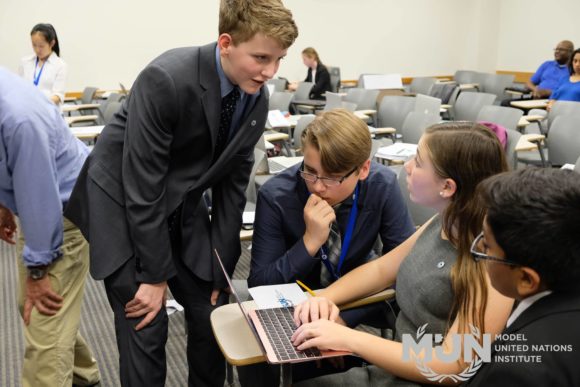Model UN has offered countless benefits to high school and university students, both academically and socially, including improving public speaking, debate, and research skills. However, Model UN is often overlooked in middle schools, especially in middle schools that are unaffiliated or unconnected to local high schools. Many middle school teachers have either not heard of Model UN or are not sure how to start and train a team. What is the best solution to this issue? Have local high school and university Model UN teams start a team themselves! The purpose of this article is to teach high school/university club leaders how to start and lead a middle school Model UN team.

Finding a Local Middle School
The first step that needs to be taken to start a middle school team is to identify local middle schools that do not currently have a Model UN team. The initial point of contact in this process is the school administration, usually the Principal, Assistant Principal, or Club Coordinator. Then, you will likely be referred to social studies or world language teachers who have displayed interest in serving as an advisor for the team. Effective communication with interested teachers is key to maintain interest, so it is recommended, in addition to email, to schedule an in-person meeting with interested teachers to explain what Model UN is and your vision and plans for the team, and to address any questions or concerns that they potentially have. This process will likely be different for each school, but these are typically the main actions that need to be taken to gain school approval for starting the team. After gaining approval and securing a team advisor, work with the advisor and other teachers to advertise to the students. Create advertising materials such as posters and flyers to distribute to students and create a video or write an advertisement that teachers could show to their students.
Training
The training process for middle school teams has several key distinguishing factors when compared to high school and collegiate training. It is likely that students aged 11-14 are not as aware of the current events and pressing global issues that are typically discussed in Model UN committees. It is also possible that these students are not sure of what the United Nations actually does, or what it even is! This is why it is crucial to explain the basics of the United Nations during the training process. However, during the initial training sessions, it is best to focus on simple non-MUN related topics. Examples of such topics include the school dress code policy or who should be the Super Bowl halftime performer. These topics require little to no research, as they mainly rely on prior knowledge or opinions, and allow the training to be focused on understanding parliamentary procedure and public speaking skills. After this, more relevant yet simple MUN topics may be introduced, such as climate change, poverty, and food security, where the focus of training will have a greater emphasis on research and debate skills.

Conferences
After completing training, members will probably want to attend an actual conference. However, there’s only one issue: there is a severe lack of middle school conferences outside of large metropolitan areas. If this is the case, hosting your own mini-conferences are a great option! Hosting 1-day informal conferences for the team offer a variety of benefits to both the middle school team and the mentor high school/collegiate team. The middle school team will benefit from this by being able to participate in a locally-based conference for little to no cost, while mentor team will gain significant experience in conference organizing. This serves as a valuable opportunity to train members of the mentor team for chairing and conference secretariat positions, thus providing more knowledge and experience that can be applied to hosting your own high school/collegiate conference. You can also invite other local middle school teams or novice high school delegates to attend the conference, allowing members of your middle school team to gain exposure to the local circuit, thus further preparing middle school students to enter the high school Model UN circuit.
Conclusion
By starting a Model UN team at local middle schools, you can ensure that students will be prepared to jump right into Model UN at the high school level. Students will also be significantly more qualified and experienced to hold club and conference leadership positions sooner in their high school Model UN careers. It also expands the local middle school circuit and increases the amount of participants in the high school and collegiate circuit. And most importantly, students will be sooner equipped with the various skills offered by participating in Model United Nations.








Comments on this entry are closed.
Love it Anusha!!! ❤️❤️❤️